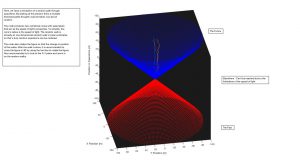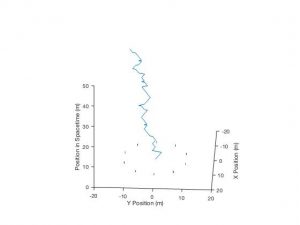Overview:
For my project, I created a 3 dimensional “random walk” and oriented it to be inside Minkowski’s spacetime light cone. In this case, since this is a physical interpretation of spacetime, the random walk was only in 2 directions (the x and y axis) and the iterated up through spacetime (the ct axis). The bottom (red cone) symbolized the past and the choices and movements up until the present (the intersection between the bottom cone and the top cone), which leads to the present, and all the possible paths that could be taken, as modeled by the random walks. Although it is a random walk and shouldn’t travel too far from the starting point, except in the ct direction, since the Minkowski light cone is the region of spacetime that can be travelled according to the speed of light, the walk must never move faster than the speed of light. That is, the random walk must never enter the space outside the cone, called Elsewhere by Minkowski.
My motivation for this project was to simulate an accurate model of motion through space time that could be used for education purposes. Spacetime is often viewed as a complex perspective of the nature world and a simulation would most likely help students understand the concepts such as elsewhere and the limits of the cone. In this simulation, the parameters of the random walk can be altered so the walk could travel in one direction until it dies, but the walk will never be able to leave the cone. This follows the laws of general relativity and can help students better understand relativity and its assumptions.
General Physics:
The general physics behind the random walk is having an equal probability of the walk’s next step to be in either the positive or negative direction for each direction (x and y).Then the constraints of a cone are applied to the walk so that the walk can never reach and surpass the boundary of the cone. However, if specific cases of this walk are analyzed, such as the case when the walk always moves in the positive direction for say the x direction, the walk can actually slip through the boundaries of the cone. This is because the walk’s symmetry, which will look like a square, does not match up with the cone’s, which is circular.
A solution to this is to get rid of this step iteration in cartesian coordinates. By changing the randomness from a two dimensional (x and y) system, we can actually change it to a one dimensional system and use polar coordinates. That way the symmetries will both be circular and there won’t be any inconsistencies between the walk and the cone.
Visualizations:
In the programming, the simulation would include a few different examples of which paths the random walks could take over a time of 100 iterations. Each walk was colored coded so that it could be distinguished from the others. While the simulation ran at a slow pace, so the observer could see the simulation run, the figure slowly rotated along the x and y direction so that the observer could truly distinguish between the walks. Also on the figure were short explanations of what each region of the figure was and confusing terms has a short physical interpretation.

In figure 1. We see the figure produced by the random walk code in 3 dimensions, with a random motion in the x and y directions, but the code actually using polar coordinates, and the ct direction, spacetime. Small text boxes are added to the figure to provide a short description to help better explain Minkowski’s spacetime light cone.

In figure 2. We see a basic image of the random walk in 3 dimensions. However this walk uses a cartesian coordinate system.
Discussion:
Throughout the process and project, I created a random walk that was confined into a cone. I am pleased with the way the code and program turned out and the computational knowledge that I learned. These walks both used the simple cartesian random walk as described by Giordano as well as one utilizing a polar coordinate system. I do believe that some additional work could be done on this project. That work includes a past random walk that leads to the present. Another interesting future project is the continuous update of the cone with each iteration of the random walks. The cone would shrink with each step as the choices the walk could take also shrink. Something else worth considering would be the relativistic effects that would occur to the particle and the walk as the particle nears the speed of light, and the boundary of the cone.
References:
Giordano, Nicholas J., and Hisao Nakanishi. Computational Physics. 2nd ed. Upper Saddle River, NJ: Prentice Hall, 2006. Print.

